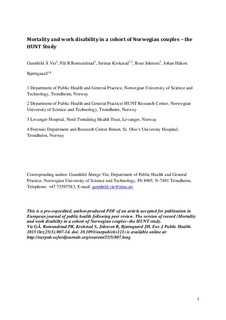| dc.contributor.author | Vie, Gunnhild Åberge | |
| dc.contributor.author | Romundstad, Pål Richard | |
| dc.contributor.author | Krokstad, Steinar | |
| dc.contributor.author | Johnsen, Roar | |
| dc.contributor.author | Bjørngaard, Johan Håkon | |
| dc.date.accessioned | 2017-12-05T09:41:42Z | |
| dc.date.available | 2017-12-05T09:41:42Z | |
| dc.date.created | 2015-11-19T08:34:40Z | |
| dc.date.issued | 2015 | |
| dc.identifier.citation | European Journal of Public Health. 2015, 25 (5), 807-814. | nb_NO |
| dc.identifier.issn | 1101-1262 | |
| dc.identifier.uri | http://hdl.handle.net/11250/2469209 | |
| dc.description.abstract | Background: Poor health is clustered in families, and partners might influence each other. We studied possible consequences of living with a spouse with poor health or unhealthy lifestyle on mortality and work disability. Methods: In total, 18 943 couples from the HUNT2 Study (1995–97) were linked to national registries and followed until December 2007, identifying deaths and disability pension retirements. Couple’s mean exposures were included together with the individual’s deviation from the couple mean in discrete time multilevel logistic regression. Results: There was weak evidence of associations between partner’s health and risk of dying. Associations between couples slightly exceeded associations within couples for smoking [odds ratio (OR) within 1.57 (95% confidence interval (CI): 1.38–1.78); OR between 1.88 (95% CI: 1.70–2.08), P value for difference 0.027] and education [OR within 1.07 (95% CI: 0.99–1.15); OR between 1.17 (1.11–1.23), P value for difference 0.065]. Indicators of partner’s health, such as self-rated health [OR within 3.17 (95% CI: 2.80–3.58); OR between 3.92 (95% CI: 3.50–4.40), P value for difference 0.014], insomnia [OR within 1.39 (95% CI: 1.18–1.64); OR between 2.11 (95% CI: 1.86–2.53), P value for difference <0.001] and symptoms of depression [OR within 1.45 (95% CI: 1.22–1.71); OR between 1.98 (95% CI: 1.69–2.31) P value for difference 0.009] were, however, associated with risk of work disability. Self-rated health and symptoms displayed stronger associations with work disability among partners than reported somatic diseases. Conclusions: This study did not indicate strong consequences of living with a spouse with poor health or unhealthy lifestyle on mortality. It did, however, indicate associations of partner’s health with work disability. | nb_NO |
| dc.language.iso | eng | nb_NO |
| dc.publisher | Oxford University Press | nb_NO |
| dc.relation.uri | http://eurpub.oxfordjournals.org/content/25/5/807.long | |
| dc.title | Mortality and work disability in a cohort of Norwegian couples - The HUNT study | nb_NO |
| dc.type | Journal article | nb_NO |
| dc.type | Peer reviewed | nb_NO |
| dc.description.version | acceptedVersion | nb_NO |
| dc.source.pagenumber | 807-814 | nb_NO |
| dc.source.volume | 25 | nb_NO |
| dc.source.journal | European Journal of Public Health | nb_NO |
| dc.source.issue | 5 | nb_NO |
| dc.identifier.doi | 10.1093/eurpub/ckv121 | |
| dc.identifier.cristin | 1290660 | |
| dc.description.localcode | © The Author 2015. Published by Oxford University Press on behalf of the European Public Health Association. All rights reserved.This is a pre-copyedited, author-produced PDF of an article accepted for publication following peer review. The version of record is available online at: http://dx.doi.org/10.1093/eurpub/ckv121. | nb_NO |
| cristin.unitcode | 194,65,20,0 | |
| cristin.unitcode | 194,65,20,15 | |
| cristin.unitname | Institutt for samfunnsmedisin og sykepleie | |
| cristin.unitname | Helseundersøkelsen i Nord-Trøndelag | |
| cristin.ispublished | true | |
| cristin.fulltext | postprint | |
| cristin.qualitycode | 1 | |
